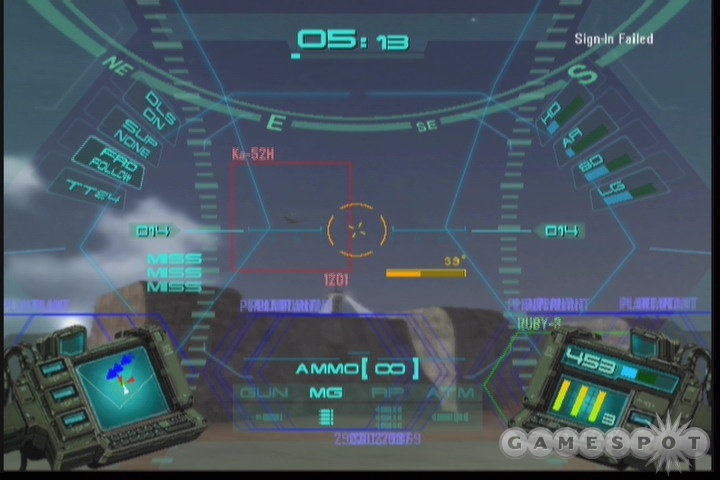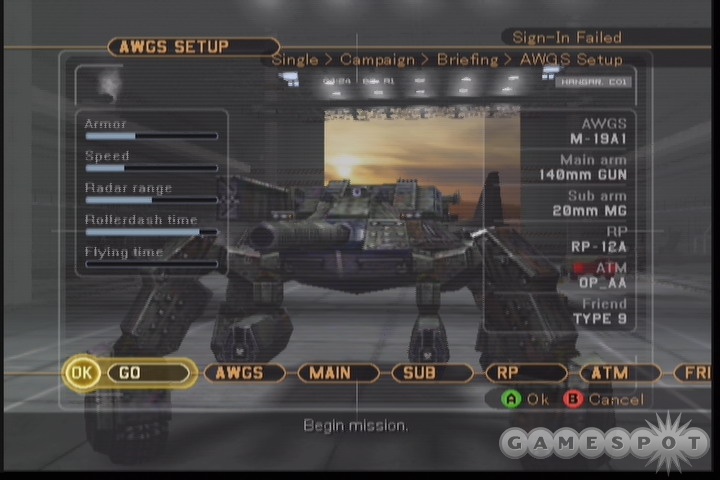GunGriffon: Allied Strike is the latest giant-robot combat game to be released on the Xbox. While it does offer a nice array of customizable AWGS (armored walking gun system) units to fight with, the game falls short in a number of areas. Primitive production values, flaws in the single-player campaign, and a sometimes lag-ridden experience in online play make GunGriffon: Allied Strike difficult to recommend.

The first thing you'll notice about GunGriffon: Allied Strike is that it looks pretty bland for an Xbox game. The lack of detail in the terrain and the excessive fogging in the distance can make it very difficult to see what's going on at first, especially because the cockpit overlay is overly complicated. You'll eventually get used to squinting through the mess and learn to spot enemy vehicles with the help of your radar. Switching to third-person mode also helps a little bit. But despite some creative robot designs and some impactful explosions, it's difficult to get over the fact that GunGriffon: Allied Strike doesn't look as good as an Xbox game should. It actually doesn't sound as good as it should, either. The sound effects are only passable, and what little voice acting there is in the game is so poorly localized, it's farcical. The text for the mission descriptions is also riddled with "Engrish."
Perhaps most egregiously, it never feels as though you're really wreaking havoc in a huge walking robot. You glide right through trees, fences, and other objects like a ghost instead of knocking them over, and your speed doesn't seem to change at all if you walk up a slope or down one. With the overall floaty feel of the controls, the artists could easily swap out the AWGS models for hovercraft, and it would make as much, if not more, sense.
GunGriffon: Allied Strike does get at least one thing right by offering a wide array of different AWGS models to choose from. Some are two-legged, lightly armored, and fast, while others are four-legged, heavily armed, and slow. Depending on which AWGS you choose, you'll be able to customize your weapons loadout before each mission. You'll select from different cannons, machine guns, rocket pods, and guided missiles. Each weapon varies in power and the amount of ammo you can carry for it. The only weapon you have that offers unlimited ammunition is the machine gun, so the choices you make in the loadout screens do have a real tactical impact on the battlefield.
The faster AWGS units are more fun to use, in part because many have limited boosting and flight capabilities. It's practical to have these options available, because many of the missions will have you scampering back and forth over a large battle area. Your control over the boost and flight functions is fairly limited, though. Once you engage either system, your fine control is taken away, and you can make only rough steering adjustments.
The single-player missions in GunGriffon: Allied Strike's campaign offer little variety. You're either engaging in search-and-destroy missions targeted at fixed structures and transport convoys, or running escort missions for your side's own soft targets. In any case, you and your AI teammates face long odds, as you'll be severely outnumbered and will take on wave after wave of enemy tanks and AWGS units. In missions where you have computer-controlled teammates, they never seem to last very long, nor be all that effective in combat. You supposedly have the ability to give simple orders to a single AI wingman, but these orders seem ineffectual in practice. Your teammates aren't the only dummies on the battlefield, however. On more than one occasion, we observed enemy units that were "stuck" running around in circles, or trying to run straight through a wall.
After you learn the quirks of the game, you can take advantage of them to make what seem like extremely difficult missions rather easy. For example, there's an early mission that requires you to destroy four oil refineries. Each refinery is surrounded by several heavily armed AWGS units that will swarm you all at once as you approach. But it's actually possible to destroy the refineries from long range, without triggering the bulk of the defending forces. As long as you don't approach too closely, they'll stand idly while their refineries go down in flames around them.
Once or twice during each mission, a supply helicopter will arrive to restock your ammo and replenish any armor you've lost in combat. Since you have limited ammunition, it's important to take advantage of every resupply opportunity, but the time the chopper will spend waiting on the battlefield is limited. Of course, with the way the missions are designed, more often than not the helicopter will choose to hover in a location that's less than convenient for you. There are other annoying quirks in the mission designs as well. In many of the escort missions, for example, the end of the escort route will take you out of the bounds of the mission area. It's rather frustrating that the game will either force you to stand at the edge of the mission-boundary area and try to defend your charges from afar, or have you run the risk of failing the mission by being out-of-bounds for too long.

GunGriffon: Allied Strike does offer deathmatch, team deathmatch, and cooperative play over Xbox Live for up to eight players. There are only three maps designed specifically for multiplayer, though eight of the game's single-player maps are also designated for deathmatching. In our testing, we found that latency seemed closely correlated to the number of players in the match. The games were a lot more playable with four or fewer players than with six to eight players, as matches of that size tended to include a lot of teleporting and be all but unplayable. When you do manage to find a match that is playable, the combat is much improved over the single-player experience. With another human at the controls of the opposing AWGS, matches feel a lot more tactical and enjoyable, although, again, the faster AWGS units with flight capability seem to have a pronounced advantage over the lumbering four-legged ones.
The problem with GunGriffon: Allied Strike is an overall lack of polish in the graphics, gameplay, and online play. With a little more work in all areas, the game could have been a solid giant-robot combat title. Instead, the game comes off half-baked. Those who simply can't get enough of this style of game may find some redeeming value in GunGriffon: Allied Strike, but everyone else might as well steer clear.